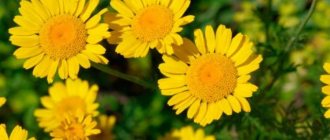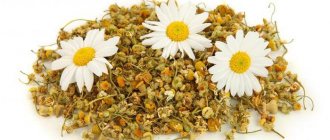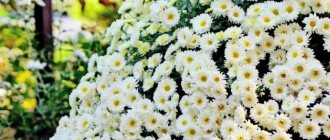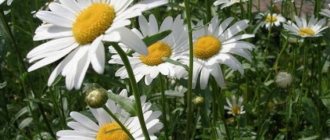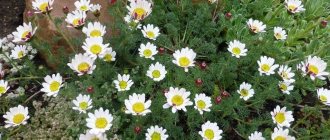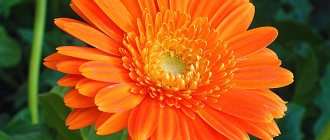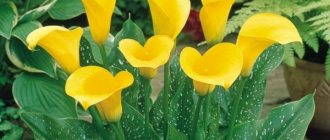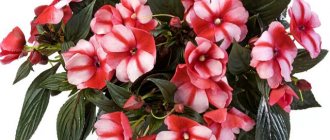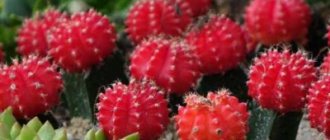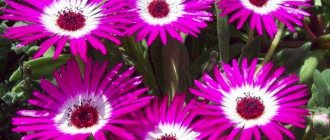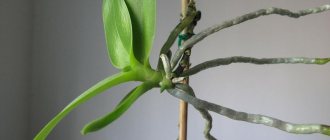≡ Home → Chamomile → Properties of chamomile →
Very often, daisies are called multi-colored flowers that are similar to them due to the structure of the inflorescences typical of aster plants. Most people associate them with a convex core and long petals, and seeing such an inflorescence, a person involuntarily calls it a chamomile. Although in most cases such plants are not daisies.
It is obvious to most people that these are not daisies, but without knowing the name, they might call them white or purple daisies for simplicity.
True daisies belong to the genus Matricaria, which, with a few exceptions, is characterized by a combination of only two colors - yellow and white. As a rule, true daisies have small tubular yellow flowers on the receptacle, and white reed flowers around it. Only two species of Matricaria - golden and green daisies do not have reed flowers, and they got their names due to the color of the tubular ones.
True chamomile
All colored or multi-colored daisies are called this only in common parlance, while in the scientific community these plants have completely different names. Most of them belong to the Asteraceae or Compositae family, which includes more than 30 thousand plant species, which explains some of their visual similarity.
Chamomile, green and golden
The most famous type of chamomile is the chamomile, which is scientifically called Matricaria chamomilla. Its leaves are very small, simple, sessile with pinnately dissected venation. Knowledge of these features helps to distinguish the plant from species with similar inflorescences.
The leaves of true chamomile are similar to dill leaves.
The size of chamomile inflorescences is about 2.5 cm in diameter. There are two types of flowers in its basket. On the convex receptacle, which as the bush ages, takes on an almost conical shape, there are small yellow flowers with a simple perianth. White reed flowers grow along the outer contour of the receptacle, the number of which is usually 12 or 18 pieces.
At the moment of flowering, the chamomile bush looks like this:
Inflorescences similar in color combinations are found in odorless chamomile, some types of navels (including dog chamomile and field chamomile), Roman chamomile, some pyrethrums and tansy.
Chamomile belongs to the genus Matricaria, which includes only 25 plants. They are considered true daisies, while other plants are called that only in common parlance, having other names.
Most species of Matricaria are characterized by the same structure of inflorescences and a combination of only yellow and white flowers. The exceptions are green chamomile, which is also called fragrant or tongueless, and in the scientific community - Matricaria discoidea, and golden chamomile - Matricaria aurea.
The green inflorescences contain only tubular flowers, which, as the name suggests, are green in color. It has no edge “petals” at all. The plant is also distinguished by a strong specific smell and the small height of the bushes. As a rule, they grow to only 20-30 cm. As can be seen from the photograph, in appearance they are very different from chamomile bushes:
The golden chamomile is quite similar to this species. It differs from green mainly only in the color of the inflorescences, which in this plant is yellow. The diameter of the inflorescences is very small - no more than 0.8 cm, and the height of the bushes is about 25 cm. An important feature of the species is that flower baskets can grow singly, and not in corymbose inflorescences, as in most other representatives of the genus Matricaria.
Ursinia
The shape of the flower is similar to a chamomile, but the color of the petals is very different. They are mostly golden with a hint of orange. The color is bright and rich, easily attracting attention. It is noteworthy that the inside of the flower is lighter than the outside. For example, a petal that is yellow on the inside will be brownish-purple on the back. The opened buds have a diameter of 5-6 cm.
The shoots grow up to 30-60 cm, covered with dark green foliage. The crop is grown both annual and perennial. It is resistant to negative temperatures and is undemanding to living conditions. Flowering continues until night frosts appear.
Yellow daisies
Many other types of aster plants also have the inflorescence structure characteristic of daisies. Because of this, they are also often called daisies, adding an epithet to describe their color. Thus, many plants are popularly called yellow daisies, while such a term does not appear in the scientific community.
Without knowing the correct names, yellow daisies are most often called:
- Doronicum orientalis;
- Coreopsis;
- Rudbeckia;
- Erigeron linearis;
- Ursinia is beautiful;
- Helenium and some other plants.
- Doronicum eastern.
Its inflorescences are larger than those of daisies, and the marginal flowers are yellow or golden in color. The plant is perennial.
It is also useful to read: What are the benefits of chamomile tea for women?
The same color is found in some species of coreopsis. Moreover, the cores of these plants can be not only yellow, but also brown or burgundy. Their reed flowers, as a rule, have jagged edges.
These photographs show several species of coreopsis:
Terry coreopsis
Various types of rudbeckia are also called yellow daisies, among which there are both annuals and perennials. Among the latter, the most common is the brilliant rudbeckia, which is characterized by a tall stem and large inflorescences. The shrubs reach a height of 60 cm, and the diameter of their inflorescences is 8-10 cm. Their petals are bright yellow and velvety to the touch, and the center is dark brown.
In flower beds and gardens you can often find hairy rudbeckia. This is an annual bush plant, smaller in size than the brilliant rudbeckia. It also differs in the color of the marginal flowers. Along the outer contour they are yellow, and in the middle they are dark burgundy or brown, as in the photo below:
Here the photo shows a beautiful Ursinia:
This annual is similar to rudbeckia in the color of the marginal flowers, but differs in the height of the bushes, which does not exceed 30 cm. Because of this, it is sometimes called small-flowered yellow daisy.
Of the wild plants, yellow daisies are called Erigeron lineart. This is a low-growing perennial shrub, the height of which is no more than 20 cm. Its inflorescences are also small - from 1 to 2 cm in diameter. They grow one at a time on separate stems.
Some types of helenium are also called. They differ in the height of the stems, which can grow up to 160 cm. At the same time, the diameter of the inflorescences rarely exceeds 5 cm. The most characteristic color for them is yellow, but cultivated varieties also have brown and purple shades. Very often helenium can be found in flower beds along with daylilies and lilies.
There are a lot of plants that resemble yellow daisies. In addition, sometimes even flowers that have more different than similar features are called this way, for example, gerberas, large-flowered chrysanthemums and asters.
Tips and recommendations from experienced flower growers and summer residents
It is recommended to grow flowers from seeds at home with seedlings in pots. The optimal time for planting is early spring. After 3 months, it is recommended to plant the plant in open ground. The place for flowers should be open to direct sunlight, as this promotes their rapid growth and flowering. The soil is fertilized and loosened, and areas with high moisture are drained. It takes root well even in mountainous areas.
red daisy
Description of the planting technique:
- Round holes are made to a depth of about 40 cm. They are cleared of weeds, large lumps are broken up, and humus and peat are poured into the bottom.
- The seedlings are moved to the prepared place, covered with soil and compacted a little.
- The planted plant is watered moderately with warm water.
Thanks to these simple steps, the result will be noticeable already on the 2nd day: the seedlings will get stronger and begin to grow by leaps and bounds. If necessary, after 2 weeks the bushes are fed with organic matter.
Flowers are easy to care for, but you still need to take into account the advice of experienced gardeners for growing a strong, lushly flowering plant:
- regular watering with a small amount of water is needed, especially in hot, dry weather;
- pruning wilted or dried parts of the bush will concentrate nutrients only on healthy areas, prolonging flowering;
- mulching helps prevent the soil from drying out in the hot summer and warms the soil in winter;
- perennial daisies are cut off almost at the root in the fall for better preservation in frosts.
For better growth, it is better to replant daisies every 3 years to new areas, as they tend to grow strongly. To propagate plants, it is recommended to use any of the methods: dividing the bush or seeds.
This is how you can easily and simply grow a simple but unusually beautiful flower on your plot. The main thing is to choose the right variety and provide minimal care.
Blue and lilac flowers
Aster plants have inflorescences with lilac and blue flowers. Without knowing the correct names, they are also called daisies. Most often it is called this:
- Pyrethrum;
- alpine aster;
- Felicia;
- Anemone;
- Catananche and some other plants.
Pyrethrum inflorescences are most similar to chamomile. Their structure is practically the same, only the size of the flower baskets and the color of the reed flowers differ. In some species they are bright lilac in color.
Alpine aster inflorescences have a yellow center, and the petals have a light lilac color. Their size and quantity are much larger than those of chamomile. In aster, reed flowers grow in 2 or 3 rows, making the inflorescence appear large and fluffy.
Several varieties of Felicia are called blue daisies. This is a small perennial shrub that produces a lot of inflorescences. In some varieties, the tubular flowers are yellow, and the marginal flowers are blue or lilac. There are also varieties with a bright blue core and blue petals.
Here the photographs show felicia ameloid shrubs:
...and bergers
And this is a tender anemone:
It has longer tubular flowers that are yellow in color and have blue-violet marginal flowers. They grow on single stems, about 20 cm high. Although the anemone is called chamomile, it not only belongs to a different genus, but also belongs to another family - Ranunculaceae.
Catananche flower baskets have a very beautiful bluish-lilac color. Their reed flowers are arranged in 3-5 rows, making the inflorescence appear larger and fluffier. The edges of the flowers are jagged, and at the base their color changes from light blue or lilac to purple.
Care for feverfew (by month)
Winter (January - February).
You can sow seeds even at such an early date if additional lighting is possible. Such early sowing produces flowering bushes by the May holidays. March. Sowing seeds for seedlings for early flowering. Shoots appear in 7 - 11 days. In order not to thin out the seedlings, small seeds are mixed with dry sand. In a room, seedlings quickly stretch, so it is better to keep them on a windowsill next to a window, on an insulated glazed loggia or on a veranda.
April. Sowing continues. It can be carried out both at home and in greenhouses. In a greenhouse or under a film, the seeds are covered with a layer of soil of 3–5 mm. In cool spring, seedlings sometimes appear later, only after 15–18 days.
May June. When planting seedlings, take into account that overgrown bushes need a space of about 25 x 30 cm. At first, the seedlings are shaded from the bright sun. Sow the seeds in open ground so that the maiden chamomile blooms by the end of summer. Self-seeding weeding. Transplanting overwintered maiden chamomile bushes and self-sowing to a new location.
July. Mass flowering of maiden chamomile. Transplanting self-seeding and flowering bushes to new places. Watering in dry times. Fertilizing on poor soils. Faded inflorescences are cut off to prevent mass self-seeding. Sowing seeds for flowering early next summer.
August. Trimming faded inflorescences. Transplanting flowering plants into pots and balcony boxes, transferring them to the veranda, balcony or windowsill. Watering in dry weather.
September. Flowering continues, as adult plants can easily tolerate frosts down to -4°C.
October, first half of November. In early winter, pruning the ground part. Mulching the soil or using spruce branches to cover varietal pyrethrums.
Maiden chamomile bush
Plants with colorful inflorescences
Some plants have multicolored inflorescences. Often 2-3, and sometimes even more, shades are combined on one petal. Thanks to this, the plants look very impressive and exotic.
It is also useful to read: All the medicinal properties of chamomile, both confirmed and unverified
Multi-colored daisies are called:
- Gaillardia spinosa;
- Osteospermum;
- Gazania;
- Venidium;
- Arctotis;
- Ursinia umbilicus and other similar flowers.
Gaillardia spinosa is a perennial shrub whose stem height reaches 90 cm. The diameter of the flower baskets is usually from 7 to 12 cm. The tubular flowers located in the center are dark red or burgundy in color. The petals of this plant are three-toothed. Along the outer edge they are colored yellow, and closer to the middle - red or purple. In some varieties they are arranged in several rows.
Gaillardia bushes look like this:
This plant is sometimes confused with helenium, some varieties of which have almost the same color of flower baskets.
Many varieties of osteospermum are also often called colored chamomile. Their inflorescences can combine a variety of shades: pink, white, red, lilac and others.
Here the photo shows osteospermum tricolor:
An abundance of color variations is also inherent in gazania. Its inflorescences are very large, and its petals are pointed. They can combine 3-4 color shades at once. The photographs show some plant varieties:
On a note
Gazania and osteospermum are often grown not only in open ground, but also in pots. Their bright inflorescences and long flowering period make them a wonderful home decoration. You can grow these flowers either from seeds or by purchasing seedlings. Their prices are much higher than for seeds, however, according to reviews, they almost always take root well.
Venidium boasts even larger and brighter flower baskets. Their diameter ranges from 10 to 14 cm, and the height of the bushes can reach 80 cm. Its reed flowers have pointed or rounded edges. They come in white, yellow, orange, red and some other colors. Moreover, in almost all varieties the center is black, and around it, on the edge flowers, a ring of a contrasting color is outlined - brown, burgundy or purple.
A similar color is found in Arctotis. Some varieties also develop a ring of a different color around the core. At the same time, its petals are more pointed, and the diameter of the baskets is slightly smaller.
Here the photo shows Venidium bushes:
And here is arctotis:
And this is Ursinia umbilicalis:
As can be seen from the photograph, its marginal flowers are colored at the base in a rich brown color, which gradually turns into burgundy, and then into bright orange.
Cosmea
The plant often evokes associations of summer warmth and comfort. Its distinctive feature is its low maintenance and self-seeding. Once you remember what these colorful daisies are called and look like, they can be distinguished in private flower beds, as tapeworms on lawns, in city park areas and along borders. A lush carpet of greenery and bright buds will decorate the garden, covering bare areas of the territory and emphasizing straight lines.
The crop easily copes with prolonged drought and heat, is undemanding to the presence of various substances in the soil, and is resistant to frost. The petals come in many shades of red and purple, and white varieties are also found. The buds are located on straight stems growing within 0.7-1.5 meters. Cosmea is used as a tapeworm and in the company of other plants. If there are empty spaces in the flowerbed, this flower often saves the day, since it manages to easily and quickly cover all the flaws.
Pink, red and other daisies
Since the Asteraceae family includes more than 30 thousand different plants, and the inflorescences of many of them have a similar structure, daisies are often called the most diverse and seemingly completely different flowers. For example:
- Anacyclus;
- Cosmea;
- Erigeron;
- Echinacea and many others.
Anacyclus is called pink daisy. Its center is yellow, and the edge petals are pale pink, but on the reverse side they are painted a rich crimson color. Anacyclus bushes are very low, its stems grow only up to 10 cm. Thanks to these features, the plant is easy to identify. Cosmos flowers are visually familiar to many, since they are often planted in flower beds, but only specialists know its correct name. Cosmos inflorescences differ from chamomile flowers not only in color, but also in size. Their petals are approximately 2-3 times wider. The color of the tubular flowers of cosmos is usually yellow, and the color of the marginal flowers is white, pink, purple or multi-colored.
Cosmos bushes look like this:
And here is a bush of phlox, with which cosmos is sometimes confused:
Erigeron is also mistakenly classified as matricaria. At the same time, plants of this species have obvious differences. Their petals are very narrow and pointed, and on the inflorescences they are arranged in several rows. The colors of flower baskets are completely different. They can combine white, yellow, lilac, burgundy, orange and other colors.
Similar to chamomile and echinacea inflorescences. Most often they come in yellow, pink and lilac colors.
Rudbeckia
The flower belongs to the tall category, the minimum height of the bush is 50 cm, and the maximum reaches 2 meters. The plant has no special care requirements; moreover, it is perennial and can decorate the garden in one place for up to 5 years.
The daisy-like flowers come in yellow, pink, scarlet, orange and cream. There are two-color species, where the darker base becomes lighter as it approaches the edge of the petal. There are 40 varieties in total.
Coreopsis whorled
A short, fluffy perennial that blooms with beautiful lemon-yellow flowers that are often confused with chamomile. It blooms profusely throughout the summer season, so it is indispensable for flowerbeds of continuous flowering. Can be used for alpine slides, garden flowerpots and flowerpots. Unpretentious, sun-loving, drought-resistant.
Coreopsis whorled
RUB 300.00
Echinacea
Large flowers with thin petals on long stems of echinacea are confused by many with chamomile. Gorgeous, abundantly flowering bushes of this flower will become an absolute decoration of your flowerbed. Echinacea loves sun, abundant watering and soil rich in humus. If you create good conditions, then growing it will not cause any trouble.
Echinacea
RUB 300.00
Features of cultivation
Perennial garden daisies can be grown in two ways - by seeds and through seedlings. The second method is preferred as it is more reliable.
Growing seedlings:
- The time for planting seed is March.
- Capacity is a container divided into cells. The soil for seedlings should be light, well-permeable to air, and contain peat and sand in equal parts.
- 2-3 seeds are placed in a cell, and a thin layer of soil mixture is poured on top. The seed is sunk into the ground to a depth of no more than 2 cm.
- The container is covered with a thin film on top, which will transmit light. You need to place the box close to the window, but not on the windowsill, so that the sun's rays do not harm the young seedlings.
- Spraying the soil is carried out as it dries. Additionally, seedlings can be fed with a growth stimulant.
- The film is removed from the container as soon as the shoots begin to appear. If the seedlings are kept at room temperature, seedlings will appear in 10-14 days.
- After removing the film, the seedlings need to be provided with at least 14 hours of daylight - if there is not enough sun, backlighting with fluorescent lamps is used.
- As soon as the seedlings reach a height of about 5 cm, the bushes are thinned. In each cell you need to leave only one, the strongest seedling.
It is recommended to prepare seedlings in separate containers, so that later it will be easier to transplant the young bushes to a permanent place in the garden.
The timing of when to plant seedlings and replant chamomile depends on the climatic conditions in a particular region.
When thinning, it is forbidden to pull seedlings out of the ground, as this will damage the adjacent root system. The plant is carefully pinched off above the ground.
Heliopsis
Much like a daisy, heliopsis blooms with bright yellow flowers on long stems. An unpretentious, drought-resistant perennial that even a novice gardener can grow. The tall bush looks beautiful in the background of flower beds, near the walls of buildings and various fences.
Heliopsis perennial
RUB 350.00
Perennial asters
Perennial asters, also called September asters, October asters and November asters. Gorgeous bushes that bloom profusely in the fall with small flowers that look like daisies. Unpretentious and drought-resistant perennial asters easily grow in the most unfavorable conditions. Very beautiful and trouble-free flowers.
Bush aster (Sentyabrinki)
RUB 220.00
Diseases, pests
Despite the unpretentiousness of flowers and resistance to various diseases, there is a possibility of diseases occurring if not properly cared for. Flowers are susceptible to the following diseases:
- rust - yellow spots appear on the leaves;
- powdery mildew - the appearance of a white coating on the leaf blades, after which the affected parts become brown;
- fusarium - infection of the root system by a fungus, as a result of which the plant quickly withers and dies;
- gray rot - leaves and stems are affected by brown spots with a grayish coating.
Diseases must be dealt with immediately, when the first signs are detected.
For minor damage to bushes, fungicides are used. If the lesion is extensive, the bush must be removed and burned.
Pests dangerous to flowers and signs of their appearance:
- aphid - deformation of the plant and its gradual death;
- wireworm - affects the root, preventing the bush from developing;
- star-winged fly - occurs when there is a large number of weeds; the insect sucks the juices from the stem, leading to its withering.
Insecticides are used to kill insects, as well as to prevent their occurrence.
The first measure to combat insects is to treat the flowers with a solution of laundry soap, but this folk remedy only helps if the number of pest colonies is small.
You can try to kill insects with a soap solution
Coreopsis dyestuff
An annual with bright yellow-burgundy flowers on a long stem, similar to a daisy, Coreopsis tinctalis. This fast-growing, low-growing annual is great for borders or multi-level beds. Blooms profusely and for a long time throughout the summer. Does not require special care, actively reproduces by self-sowing. It is enough to plant it once and let the seeds ripen, and every spring it will produce young shoots.
Zinnias
These beauties, on the contrary, feel great in the Moscow region. Annual zinnias are easy to grow as they do not require much care. Externally similar to a daisy, multi-colored zinnia flowers on long stems look especially beautiful in a group. They bloom at the end of June until frost. They are easily propagated by seeds, but without self-sowing - they do not sprout after winter, they need to be specially collected and dried. I plant zinnias for myself every year, and I can offer both seeds and seedlings if you are in our area.
There are many beautiful and unpretentious flowers that look similar to an ordinary chamomile. My list with names and photos contains mainly those that are easy to grow in a summer cottage in the Moscow region. Annuals or perennials, they will delight you with abundant blooms throughout the season.
Yukka Gritsenko
Novice agronomist, amateur gardener. I study at the Timiryazev Academy, collecting a collection of garden plants. Seedlings with delivery can be ordered through my online store Blossomok.ru
